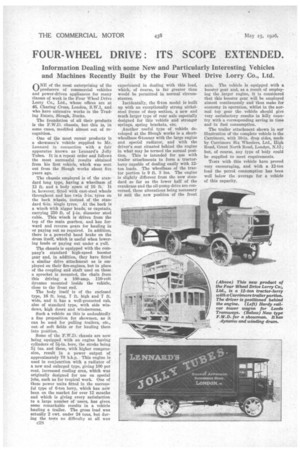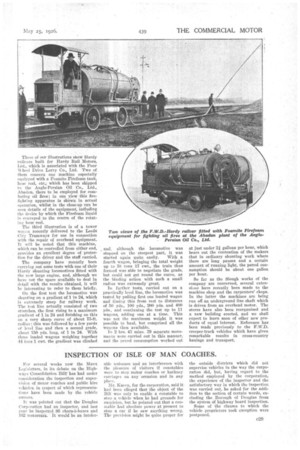FOUR-WHEEL DRIVE: ITS SCOPE EXTENDED.
Page 12

Page 13

If you've noticed an error in this article please click here to report it so we can fix it.
Information Dealing with some New and Particularly Interesting Vehicles and Machines Recently Built by the Four Wheel Drive Lorry Co., Ltd.
CI NE of the most enterprising of the
producers of commercial vehicles and power-driven appliances for many classes of work is the Four Wheel Drive Lorry Co., Ltd., whose offices are at 46, Charing Cross, Loudon, S.W.1, and. who have extensive works in the Trading Estate, Slough, Bucks.
The foundation of all their products is the F.W.D. chassis, but this is, in some cases, modified almost out of recognition.
One of the most recent products is a showman's vehicle supplied to Mr. Lennard in connection with a fair apparatus known as Lenn.ard's Jolly Tubes. It is a repeat order and follows the most successful results obtained from his first vehicle, which was sent Out from the Slough works about five years ago. •
The chassis employed is of the standard long type, having a wheelbase of 13 ft. and a body space of 16 ft. It is, however, fitted with east-steel wheels throughout and has twin 5-in. tyres on the back wheels, instead of the standard 6-in. 'single tyres. At the back is a winch with nigger beads; or capstans, carrying 250 ft. of g-in. diameter steel cable. This winch is driven from the top of the main gearbox, and has forward and reverse gears for hauling in or paying out as required. In addition, there is a powerful band brake on the drum itself, which is useful when lowering loads or paying out under a pull.
The chassis is equipped with the company's standard high-speed booster gear and, in addition, they have fitted a similar drive attachment as is employed on their fire-engines, but in place of the coupling and shaft used on these a sprocket is mounted, the chain from this driving a 100-amp. 110-volt dynamo mounted inside the vehicle, close to the front end.
The body itself is of the enclosed type, 16 ft. long, 7 ft. high and 7 ft. wide, and it has a well-protected cab, also of standard type, with side windows, high doors and windscreens.
Such a vehicle as this is undoubtedly a fine proposition for showmen, as it can be used for pulling trailers, etc., out. of soft fields or for hauling them into position.
Some of the F.W.D. chassis are now being equipped with an engine having cylinders of 5k-in. bore, the stroke being 5i ins, and these, with higher compression, result in a power output of approximately 70 b.b.p. This engine is used in conjunction with a radiator of a new and enlarged type, giving 100 per cent, increased cooling area, which was originally designed for use on special jobs, such as for tropical work. One of
these power units fitted in the successful type of 6-ton lorry, which has now been on the market for over 12 months
and which is giving every satisfaction to a large number of users, has given some remarkable results in a vehicle hauling a trailer. The gross load was actually 2 cwt. under 24 tons, but during the tests no difficulty at all was c28
experienced in dealing with this load, which, of course, is far greater than would be permitted in normal circumstances.
Incidentally, the 6-ton model is built up with an exceptionally strong nickelsteel frame of deep section, a new and much larger type of rear axle especially designed for this vehicle and stronger springs, spring brackets, etc.
Another useful type of vehicle developed at the Slough works is a shortwheelbase 6-tonner with the large engine and special radiator, and with the driver's seat situated behind the engine in what may be termed the normal position. This is intended for use with trailer attachments to form a tractorlorry capable of dealing easily with 12ton loads. The wheelbase of the tractor portion is 9 ft. 3 ins. The engine is slightly different from the new standard so far as the lower half of the crankcase and the oil-pump drive are concerned, these alterations being necessary to suit the new position of the front axle. The vehicle is equipped with a booster gear and, as a result of employing the larger engine, it is considered that this booster gear will be employed almost continuously and thus make for economy in operation, whilst in the norteal top gear the vehicle should give very satisfactory results in hilly country with a corresponding saving in time and in. fuel consumption.
The trailer attachment shown in our illustration of the complete vehicle is the Carrimore, with 30-in, drop sides, made by Carrimore Six Wheelers, Ltd., High Road, Great North Road, London, N.12; but, of course, any type of body could be supplied to meet requirements.
Tests with this vehicle have proved very encouraging, and with a 12-ton load the petrol consumption has been well below the average for a vehicle of this capacity. Three of cerr illustrations show Hardy railcars built for Hardy Rail Motors, Ltd., which is associated with the Four Wheel Drive Lorry Co., Ltd. Two of them concern one machine especially equipped with a Foamite Firefoam tank, hose reel, etc., which has been shipped to the Anglo-Persian Oil Co., Ltd., Abadan, there to be employed for combating oil fires ; in one view this firefighting apparatus is shOwn in actual operation, whilst in the close-up can be seen details of the equipment, inaluding the device by which the Firefoam liquid is conveyed to the centre of the rotatlug hose reel.
The third illustration is of a tower waisdi recently delivered to the Leeds City Tramways for use in connection with the repair of overhead equipment. It will be noted that this machine, which can be controlled from either end, provides an excellent degree of protection for the driver and the staff carried.
The company have recently been carrying out some tests with one of their Hardy shunting locomotives fitted with the new large engine, and, although we have not the space available to deal in detail with the results obtained, it will he interesting to refer to them briefly.
On the first test the locomotive was shunting on a gradient of 1 in 24, which is extremely steep for railway work. The test line actually consisted of two stretches, the first rising to a maximum gradient of 1 in 24 and finishing on this on a very sharp curve of about 75-ft. radius : this was followed by a few yards of level line and then a second grade, about 150 yds. long, of 1 in 24. With three loaded wagons weighing together 44 tons 1 mt. the gradient was climbed and, although the locomotive was stopped on the steepest part, it was started again quite easily. With a fourth wagon, bringing the total weight up to 58 tons 17 cwt., the train thus formed was able to negotiate the grade, but could not get round the curve, as the binding action with such a small radius was extremely 'great.
In further tests, carried out on a practically level line, the locomotive was tested by pulling first one loaded wagon and timing this from rest to distances of 50 yds., 100 yds., 200 yds. and 400 yds., and continuing the test up to 11 wagons, adding one at a time. This was not the maximum weight it was possible to haul, but comprised all the wagons then available.
In 2 hrs. 43 mins. 29 separate movements were carried out in this manner,and the petrol consumption worked out at just under 21 gallons per hour, which bears out the contention of the makers that in ordinary shunting work where there are long pauses and a certain amount of running light, the petrol consumption should be about one gallon per hour.
So far as the Slough works of the company are concerned, several eatensiaas have recently been made to the machine shop and the carpenters' shops. In the latter the machines are being run off an underground line shaft which is driven from an overhead motor. The stores have also been reorganised and a new building erected, and we shall expect to learn soon of other new products of equal interest Reference has been made previously to the F.W.D. creeper-track vehicles which have given remarkable results in cross-country haulage and transport.


























































